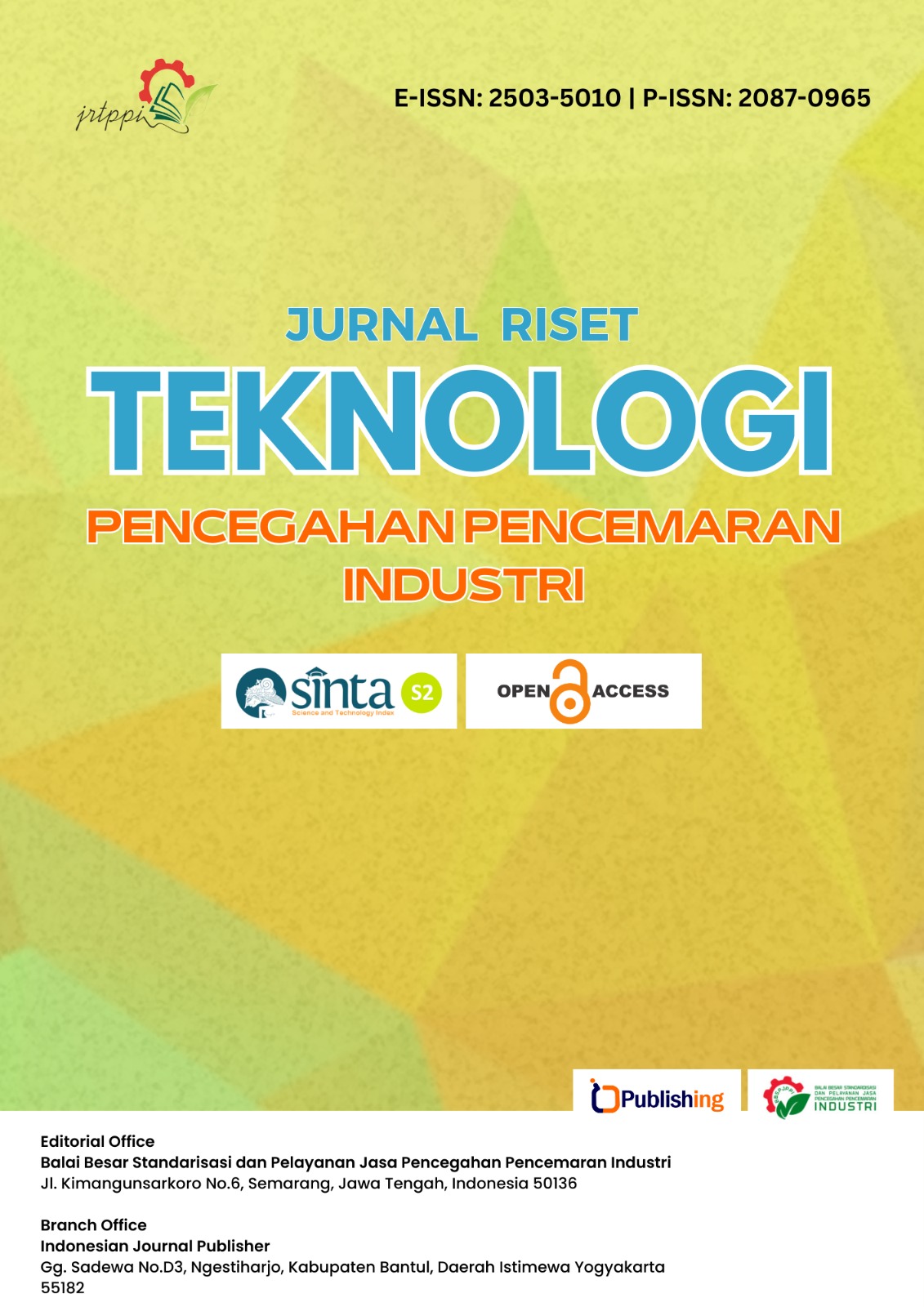Soil Characteristics in Post-Mining Reclamation Zones of a Clay Mine PT Solusi Bangun Indonesia Tbk Cilacap
DOI:
https://doi.org/10.21771/jrtppi.2024.v15.no2.p78-85Keywords:
Post-Mining Reclamation, Clay Mine, Soil Characteristics, XRFAbstract
Former clay mining areas often face soil degradation that makes it difficult for vegetation to thrive, even after reclamation. This study explores the physical and chemical characteristics of soil in the reclaimed land of PT Solusi Bangun Indonesia Tbk in Cilacap, aiming to understand how effective the rehabilitation efforts have been. Soil samples were taken from six locations, chosen based on differences in vegetation cover and land elevation. The analysis focused on physical properties such as pH, moisture content, temperature, specific gravity, and porosity, along with chemical aspects like macronutrient levels and heavy metal content. Results showed that soil pH ranged from neutral to slightly acidic, with moisture content varying across the site. While macronutrients were generally adequate for plant growth, their distribution was uneven. Some heavy metals, particularly cadmium and silver, were found in concentrations above recommended environmental limits, whereas lead and arsenic levels remained within safe thresholds. Overall, the reclamation process has helped improve soil conditions, but additional steps—like adding lime, incorporating organic matter, and applying specific remediation techniques—are needed to boost soil fertility and reduce contamination risks. Continued monitoring and adaptive strategies will be key to sustaining the health of the reclaimed landscapeReferences
Absori, A., Yulianingrum, A. V., Dimyati, K., Harun, H., Budiono, A., & Disemadi, H. S. (2021). Environmental health-based post-coal mine policy in east borneo. Open Access Macedonian Journal of Medical Sciences, 9(E), 740–744. DOI: https://doi.org/10.3889/oamjms.2021.6431
Ahmad, H., & Li, J. (2021). Impact of water deficit on the development and senescence of tomato roots grown under various soil textures of Shaanxi, China. BMC Plant Biology, 21(1), 241. DOI: https://doi.org/10.1186/s12870-021-03018-1
Antisari, L. V., Ferronato, C., De Feudis, M., Natali, C., Bianchini, G., & Falsone, G. (2021). Soil biochemical indicators and biological fertility in agricultural soils: A case study from northern Italy. Minerals, 11(2), 1–15. https://doi.org/10.3390/min11020219 DOI: https://doi.org/10.3390/min11020219
Arefieva, O., Nazarkina, A. V, Gruschakova, N. V, Skurikhina, J. E., & Kolycheva, V. B. (2019). Impact of mine waters on chemical composition of soil in the Partizansk Coal Basin, Russia. International Soil and Water Conservation Research, 7(1), 57–63. https://doi.org/https://doi.org/10.1016/j.iswcr.2019.01.001 DOI: https://doi.org/10.1016/j.iswcr.2019.01.001
Bastida, F., Zsolnay, A., Hernández, T., & García, C. (2008). Past, present and future of soil quality indices: a biological perspective. Geoderma, 147(3–4), 159–171. DOI: https://doi.org/10.1016/j.geoderma.2008.08.007
Bosiacki, M., Kleiber, T., & Markiewicz, B. (2014). Continuous and Induced Phytoextraction — Plant-Based Methods to Remove Heavy Metals from Contaminated Soil. In M. C. Hernandez Soriano (Ed.), Environmental Risk Assessment of Soil Contamination. Rijeka: IntechOpen. https://doi.org/10.5772/57257 DOI: https://doi.org/10.5772/57257
Cancer, I. A. for R. on. (1993). Cadmium and cadmium compounds. Monographs on Evaluation of Carcinogenic Risks to Humans, 58, 119–237.
Caponetti, E., Caminiti, R., Chillura Martino, D., & Saladino, M. L. (2007). Energy Dispersive X‐Ray Diffraction Potentiality in the Field of Cultural Heritage: Simultaneous Structural and Elemental Analysis of Various Artefacts. Annali Di Chimica: Journal of Analytical, Environmental and Cultural Heritage Chemistry, 97(7), 473–490. DOI: https://doi.org/10.1002/adic.200790031
Carlon, C., Critto, A., Marcomini, A., & Nathanail, P. (2001). Risk based characterisation of contaminated industrial site using multivariate and geostatistical tools. Environmental Pollution, 111(3), 417–427. https://doi.org/https://doi.org/10.1016/S0269-7491(00)00089-0 DOI: https://doi.org/10.1016/S0269-7491(00)00089-0
Courtney, R., & Pietrzykowski, M. (2018). Soil quality indices for evaluation of acid mine spoil. In Bio-geotechnologies for mine site rehabilitation (pp. 33–48). Elsevier. DOI: https://doi.org/10.1016/B978-0-12-812986-9.00002-6
Darwis, H., & Sc, M. (2018). Dasar-Dasar Mekanika Tanah. Yogyakarta: Pena Indis.
Fan, X., Song, Y., Zhu, C., Balzter, H., & Bai, Z. (2021). Estimating ecological responses to climatic variability on reclaimed and unmined lands using enhanced vegetation index. Remote Sensing, 13(6), 1100. DOI: https://doi.org/10.3390/rs13061100
Grim, R. E. (2005). Clay mineralogy McGraw Hill Book Company. JOUR GEOL SOC INDIA, 66, 171–179.
Hardjowigeno, S. (1995). Ilmu tanah Hutan. CV Akademika Pressindo. Jakarta.
Mohammed, S. A., & Denboba, M. A. (2020). Study of Soil Seed Banks in Ex-closures for Restoration of Degraded Lands in the Central Rift Valley of Ethiopia. Scientific Reports, 10(1). https://doi.org/10.1038/s41598-020-57651-1 DOI: https://doi.org/10.1038/s41598-020-57651-1
Nomicisio, C., Ruggeri, M., Bianchi, E., Vigani, B., Valentino, C., Aguzzi, C., … Sandri, G. (2023, May 1). Natural and Synthetic Clay Minerals in the Pharmaceutical and Biomedical Fields. Pharmaceutics. MDPI. https://doi.org/10.3390/pharmaceutics15051368 DOI: https://doi.org/10.3390/pharmaceutics15051368
Nurcholis, M., Wijayani, A., & Widodo, A. (2013). Clay and organic matter applications on the coarse quartzy tailing materiaand the sorghum growth on the post tin mining at Bangka Island. Clay and Organic Matter Applications on the Coarse Quartzy Tailing Materiaand the Sorghum Growth on the Post Tin Mining at Bangka Island, 1(1), 27–32. DOI: https://doi.org/10.15243/jdmlm.2013.011.027
Oyedotun, T. D. T. (2018). X-ray fluorescence (XRF) in the investigation of the composition of earth materials: a review and an overview. Geology, Ecology, and Landscapes, 2(2), 148–154. DOI: https://doi.org/10.1080/24749508.2018.1452459
Sarathchandra, S. S., Rengel, Z., & Solaiman, Z. M. (2023, May 1). A Review on Remediation of Iron Ore Mine Tailings via Organic Amendments Coupled with Phytoremediation. Plants. MDPI. https://doi.org/10.3390/plants12091871 DOI: https://doi.org/10.3390/plants12091871
Thalib, P., Kurniawan, F., Aliansa, W., & Maulani, A. F. (2020). Post-Mining Reclamation as An Environmental Policy: A Gold Mining Case Study, 4, 208–218. Retrieved from http://ojs.uho.ac.id/index.php/holrev/ DOI: https://doi.org/10.33561/holrev.v4i2.14290
Tsuji, K. (2019). X-Ray Fluorescence and Emission | X-Ray Fluorescence Theory☆. In P. Worsfold, C. Poole, A.
Townshend, & M. Miró (Eds.), Encyclopedia of Analytical Science (Third Edition) (pp. 471–481). Oxford: Academic Press. https://doi.org/https://doi.org/10.1016/B978-0-12-409547-2.14474-9 DOI: https://doi.org/10.1016/B978-0-12-409547-2.14474-9
Wang, X., Chi, Y., & Song, S. (2024). Important soil microbiota’s effects on plants and soils: a comprehensive 30-year systematic literature review. Frontiers in Microbiology. Frontiers Media SA. https://doi.org/10.3389/fmicb.2024.1347745 DOI: https://doi.org/10.3389/fmicb.2024.1347745
Downloads
Published
How to Cite
License
Copyright (c) 2024 Rendy Prihatnanto, Bambang Yulianto, Jafron Wasiq Hidayat

This work is licensed under a Creative Commons Attribution-NonCommercial-ShareAlike 4.0 International License.











